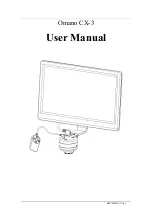
8
Basic Operation:
Before using the probe, the batteries or specified power adaptor must be
installed. See the battery installation instructions on page11.
WARNING!
Do not clamp the probe onto circuits with voltages greater than 600
VAC. Personal injury or damage to the probe may result.
Always connect the PA-659 current probe output to the instrument
before clamping onto the circuit under test.
1. First connect the current probe BNC connector to BP-250 (double BNC
connection cable) then connect to oscilloscope input. Start by setting the
oscilloscope voltage input channel to DC volts, and the voltage sensitivity
scale to 0.1 V/div.
2. Move the OFF/ Range switch to the 20 mV/A or 200 mV/A position to
turn on the probe.
(
※
The PA-659 current probe has a green LED power/battery indicator. If
the LED does not light, replace the battery or use specified power
adaptor.)
3. Use the ZERO adjustment to zero or offset the probe output detection of
residual magnetic DC charges.
4. Connect the probe to the circuit by opening the jaws and clamping
around the conductor. See Figure 2.
NOTE.
Clamping around both the “hot” and neutral wires may give
you a zero reading.
(Remember to unclamp the probe from the conductor before
disconnecting it from your meter or instrument).
Figure 2: Connecting the PA-659 current probe.
Содержание PA-659
Страница 2: ...1 ...
Страница 4: ...3 PA 659 150 Amp AC DC Current Probe ...
Страница 17: ...16 Figure 7 Maximum current versus frequency Figure 8 DC signal linearity in the 20 mV A range typical ...
Страница 21: ...20 PA 659 150 安培 交流 直流 電流探測鉗 ...
Страница 34: ...33 圖 7 最高電流量對頻率 圖 8 典型的 DC 信號線性在 20 mV A 範圍時 ...
Страница 39: ......
Страница 40: ...1 TINSE41 Ver 03 Made In Taiwan ...










































